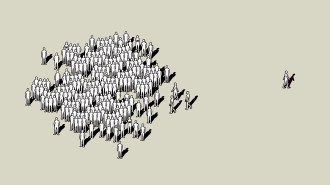Research & Design
-
Citizens for science
Students will explore the concept of citizen science and use their hobbies and interests to find a citizen science project they could participate in. -

- Educator Guide:Educator Guide
- Topic:Science & Society
- Category:Data Analysis
- Category:Research & Design
Look to the Outliers
In this guide, students will learn about outliers and why some social scientists study them in an effort to improve people’s lives. -
All about outliers
Students will define what an outlier is and discuss why outliers occur, how to identify them and how they can be useful for science and society. -
The physics of flying seeds
Students will design and build models inspired by flying seeds with the goal of making the models travel as far as possible. Students will test the models, analyze which ones performed the best and explain why those models performed well using physics principles. -
Reimagining plastics recycling
Students will evaluate experimental methods for recycling plastics, gather data about the types of plastics they use at home, research plastics recycling in their community and write a letter to local officials that advocates for improving plastics recycling. -

- Educator Guide:Educator Guide
- Topic:Science & Society
- Category:Research & Design
- Category:Coronavirus
When Fans Are Away, Home Teams Lose Their Sway
In this guide, students will learn about scientific research into bias in sporting events that was made possible by the coronavirus pandemic. Then, students will define and discuss the role of questions in the scientific method before brainstorming a scientific question of their own. -
Why ask scientific questions?
Students will discuss the definition and importance of scientific questions, explore questions that scientists were able to investigate because of the coronavirus pandemic and brainstorm their own scientific questions. -
Planning ahead to prevent future disasters
Students will take on the role of a planning board for a region identified as having an increased risk for natural hazards — wildfires, floods, droughts, heatwaves or hurricanes — due to climate change. After proposing regulations and other strategies to reduce the natural hazard’s impact, the students will discuss the merits of the proposed solutions before voting on a disaster plan and budget for their region. -
Building better boxes based on beetles
In this activity, students will learn about the seemingly indestructible diabolical ironclad beetle and review Newton’s laws of motion and force diagrams. Then, students will design, build and test crush-resistant packaging using biomimetics, the practice of solving problems using solutions inspired by biological structures and systems. -
- Exercise type:Activity
- Topic:Science & Society
- Category:Research & Design
- Category:Diversity in STEM
Diversity in science
Students will explore diversity in the STEM community and discuss how future textbooks might highlight the scientific contributions of the women who won the 2020 Nobel Prize in chemistry. Students also will research and present on the achievements of women in STEM throughout history. -
How a scientific theory is born
Students will discuss the development of the theory of plate tectonics to determine how scientific theories are created. -
- Exercise type:Activity
- Topic:Science & Society
- Category:Research & Design
- Category:Diversity in STEM
How bias affects scientific research
Students will study types of bias in scientific research and in applications of science and engineering, and will identify the effects of bias on research conclusions and on society. Then, students will discuss how biases can be eliminated — or at least recognized and addressed — and develop bias prevention guidelines of their own.